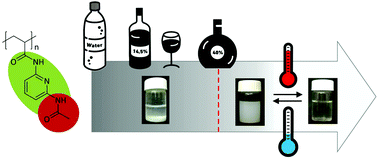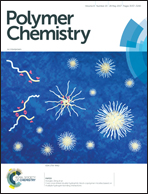Thermoresponsive functional polymers based on 2,6-diaminopyridine motif with tunable UCST behaviour in water/alcohol mixtures†
Abstract
2,6-Diaminopyridine based functional polymers poly(N-(6-aminopyridin-2-yl)acrylamide) (PNAPAAm) and poly(N-(6-acetamidopyridin-2-yl)acrylamide) (PNAcAPAAm) were synthesized via free radical polymerization and in addition PNAcAPAAm was synthesized by reversible addition–fragmentation chain transfer (RAFT) polymerization for comparison. The obtained polymers displayed upper critical solution temperature (UCST)-type reversible thermoresponsiveness in water/alcohol mixtures. The UCST phase transition behaviour of the obtained functional polymers was studied using temperature dependent turbidimetry, dynamic light scattering and 1H-NMR measurements. The phase transition temperature of the polymers was tunable by varying either the concentration of the polymer solution, the nature of the alcohol or the composition of the solvent mixture. The cloud point temperature of PNAcAPAAm was found to decrease with increasing alcohol content (MeOH, EtOH and iPrOH) in water/alcohol mixtures. Past a critical amount of EtOH or iPrOH in water, the cloud point temperature of PNAcAPAAm increased upon further addition of EtOH or iPrOH. Such functional polymers with tunable UCST behaviour can be applicable in drug delivery, sensing, personal care and microfluidic applications.



 Please wait while we load your content...
Please wait while we load your content...